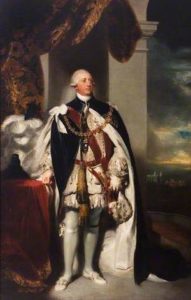Below is the detailed biography of King George III of Great Britain and Ireland. His period of the reign was from 1760 until the year 1820. He was the third British Monarch from the House of Hanover, however, he was born in London and spoke English as his first language. Let us learn more about him below.
Early Life of King George III

King George III was born in London in St Jame’s Square, a royal residence. His father was Frederick, the Prince of Wales and mother was Augusta of Saxe Gotha. His father died a sudden death while he was as young as 17 years old. His grandfather George II was the King of Great Britain and Ireland at the time.
As a young boy, he is known to have been shy in nature yet smart and bold enough to have the qualities of a Prince. He had close relations with his younger brother Prince Edward, the Duke of York and Albany as they grew up together. They were both home educated by private tutors that taught them English and German. By the time the boys were eight, they were writing letters in English as well as German.
They were taught current affairs and political events since a very young age and a systematic study of science was taken. They learned Physics, Maths, French, History, Geography, Commerce and Constitutional Law.
The Kingship of King George III
He grew up into a young boy brought up by his mother with strict Anglican values. His father died at the age of 44, this made him the apparent heir to the throne and therefore, his grandfather now took a special interest in him. After the death of King George II, when George III was 22 years old, he succeeded him as King of Great Britain and Ireland. This was in the year 1760.
Early Reign of King George III
As Prince of Wales, George III gained great popularity by the people of England. When he became King and gave his speech, people cheered with praises. In the early years of his reign, he struggled with political instability due to the many disagreements from his side in the seven years war. He also seemed to have been torn between the Whigs and the Tories.
Many times the public found him favoring the Tory ministers more than others. Financially also, he was in a bad position due to his 3 million pounds debt which the Parliament had to bear. This deteriorated his reputation before the people.
However, as he caught on with the monopoly of the monarchy, he became better in his administration. He provided large funds to the Royal Academy of Art contributing from his own private funds. A lot of his personal income also went to charity.
He had a massive art and book collection. He bought paintings from the Academy and paid the painters a large fortune that encouraged them to continue being excellent at what they do.
During his time of reign, many significant events took place that influenced the life of the people as well as their involvement in the system. The American War of Independence and the Stamp Act in America against the Englishmen are ones to name a few. The Stamp act proclaimed the theory of ‘no taxation without representation’.
During these times, he relied on his minister Lord Rockingham and other members of the parliament to make the decisions. He firmly supported them in the various policies they wished to propose.
Administrative Issues
After the death of Whig minister Lord Rockingham, Lord Shelburne replaced the position. However, this was not acceptable by the House of Commons. Later on, they appointed William Henry Cavendish, the Duke of Portland to be the Prime Minister and Lord Shelburne was appointed the Home Secretary.
The King had clashes with the newly appointed foreign secretary – Charles James Fox. He was considered ‘unprincipled’ and ‘bad influence’ by the King.
King George III worked with several ministers and statesmen during his course of the regime.
Later Life of King George III
As George III grew older, he lost his eyesight due to cataract in both eyes. He was immensely depressed due to the death of his young daughter Princess Amelia. It is reported by the staff that the King cried every day in this distress and eventually became severely ill.
Even though he was alive and moving, he was unfit to rule the kingdom. He, therefore, accepted the Regency Act of 1811 and allowed his son, the Prince of Wales to take charge of the administration as the Regent of the United Kingdom of Great Britain and Ireland.
During the month of May 1811, he showed a few signs of recovery. However, he became permanently insane for the rest of his life. He remained secluded at the Windsor Castle for the remainder of his life.
Over time, he developed dementia and became completely blind and also became deaf. He had no sense of what was going on around him. He was absolutely unaware of the fact that his wife had died in the year 1818.
Death of King George III
In the year 1819, he became completely bedridden and could not walk. The following year on the 29th of January, he died at the Windsor Castle.
His grand burial ceremony took place on the 16th of February 1820 at St George’s Chapel in the Windsor Castle.
Legacy of King George III
King George III reigned for 59 years as King which makes him the third longest reigning monarch of the British History. He was the only King that was called the man of the people. His interests included taking an interest in the lives of people and making it better rather than issues of politics and war.
His massive collection of portrait paintings and landscape painting lie on the walls of the Windsor Castle. His collection of Mathematical instruments are housed at the Science Museum in London.